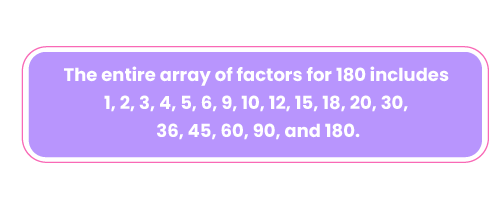Welcome to an insightful journey into the factors of 180. This guide is designed to illuminate the numbers that combine multiplicatively to total 180. Whether you’re a math enthusiast or simply seeking to enhance your numerical knowledge, this guide is crafted to suit your needs. Let’s explore the number 80 in detail and simplify the understanding of its factors.
What Are the Factors of 180?
The factors of 180 are the numbers that multiply together to give the sum of 180. These factors are fundamental in understanding the composition of 180. Examples of factor pairs include 1 and 180, 2 and 90, 3 and 60, and so forth.
Pair Factors of 180
The number 180 pair factors are sets of two numbers that result in 180 when multiplied together. This concept extends to both positive and negative pairs, as the multiplication of two negatives also yields a positive result.
Positive and Negative Pair Factors of 180:
How to Find the Factors of 180?
To ascertain the factors of 180, you can employ the following steps:
1. Starting Point:
Pairing 1 with 180, as 1 multiplies with any number to yield the number itself.
2. Investigating Divisibility:
Seek numbers that evenly divide 180—for instance, 2 pairs with 90 and 3 pairs with 60.
3. Considering Square Roots:
Examine numbers up to and including the square root of 180 for possible factors.
4. Including Negatives:
Always pair each positive factor with its negative counterpart.
Thus, the factors of 180, are 1, 2, 3, 4, 5, 6, 9, 10, 12, 15, 18, 20, 30, 36, 45, 60, 90, and 180
Along with their negative versions, -1, -2, -3, -4, -5, -6, -9, -10, -12, -15, -18, -20, -30, -36, -45, -60, -90, and -180.
Prime Factorization Method
Prime factorization involves deconstructing a composite number to its prime components, the fundamental prime numbers that, when multiplied, reconstruct the original number.
Prime factorization involves breaking down a number into its most minor prime number factors. The process for 180 is as follows:
1. Start with the Smallest Prime Number:
Begin with the smallest prime number that divides 180, which is 2.
2. Proceed with Division:
Divide 180 by 2, resulting in 90. Continue dividing with the next smallest prime, 3.
Proceed until only primes remain.
3. List the Prime Factors:
Since 180 is (2x2x3x3)x5 or (36×5),
and 2, 3 and 5 are prime numbers;
The prime factorization of 180 is
36×5.
Summary
This guide provides a deep understanding of the factors of 180. Discover how multiplicative pairings, such as 1 and 180, 2 and 90, and 3 and 60, along with their negative equivalents, contribute to the composition of 180. This guide not only presents these pairings but also demonstrates how to identify them through division and prime factorization.
The prime factorization of 180, which simplifies to 36×5 or 22x32x5, further elucidates the concept for mathematics enthusiasts.
They not only deepen your mathematical understanding but also sharpen your problem-solving skills. Whether you’re in the classroom or facing real-world mathematical challenges, mastering these methods will undoubtedly prove beneficial.
Frequently Asked Questions on Factors of 180
Q1. What are the factors of 180?
Ans. The factors of 180 are numbers that multiply together to give 80: 1, 2, 3, 4, 5, 6, 9, 10, 12, 15, 18, 20, 30, 36, 45, 60, 90, and 180.
Q2. How do I calculate the factors of 180?
Ans. To identify the factors of 180, begin with the number 1 and check which numbers evenly divide 180 without leaving a remainder.
Q3. Does 180 have negative factors?
Ans. Yes, each positive factor of 180 has a negative counterpart, meaning -1, -2, -3, -4, -5, -6, -9, -10, -12, -15, -18, -20, -30, -36, -45, -60, -90, and -180 are also factors.
Q4. What is the prime factorization of 180?
Ans. The prime factorization of 180 is 22x32x5.
Q5. Are the factors of 180 useful in daily life?
Ans. Indeed, understanding the factors of 180 can be beneficial in various practical scenarios, like organizing objects or in mathematical problem-solving.
Moonpreneur understands the needs and demands this rapidly changing technological world is bringing with it for our kids. Our expert-designed Advanced Math course and Math Quiz for grades 3rd, 4th, 5th, and 6th will help your child develop math skills with hands-on lessons, excite them to learn, and help them build real-life applications.
Register for a free 60-minute Advanced Math Workshop today!


















